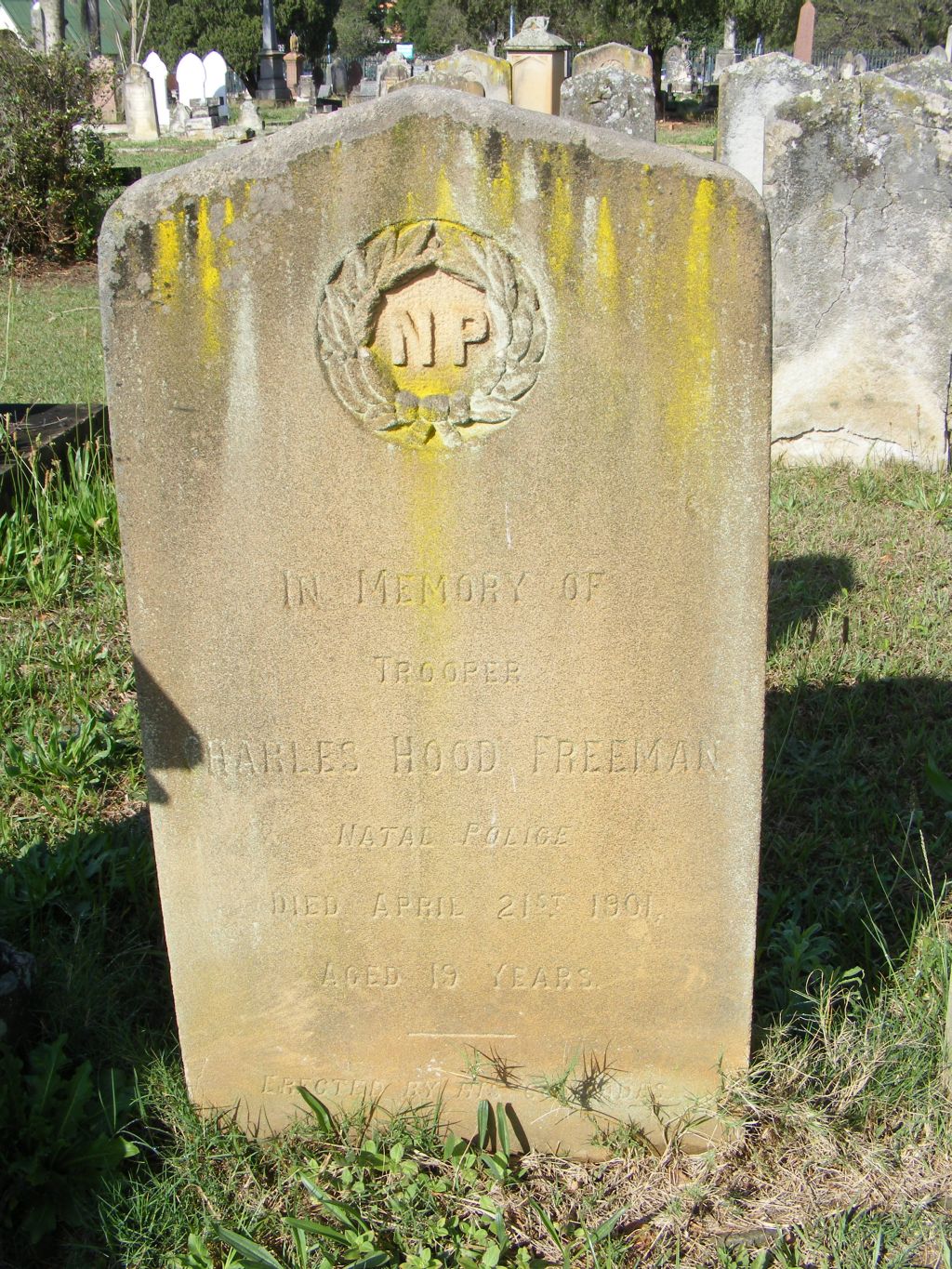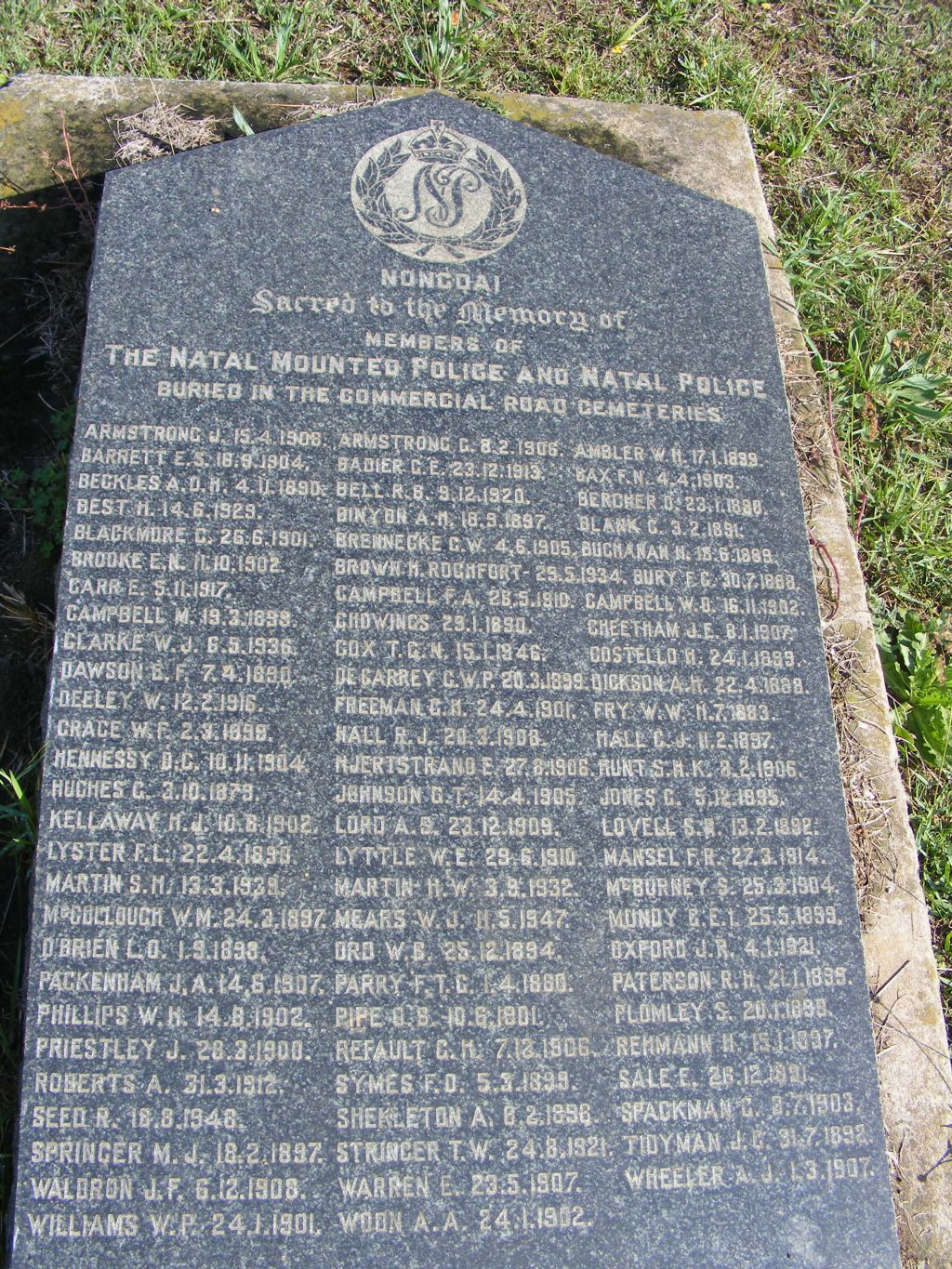
Personal Details of Charles Hood Freeman
| Born: | |
| Died: | 21/04/1901 |
| Buried: |
Please note that this person is not acutally buried in Newtown Road Cemetery, but is remembered here on a family grave or memorial.
Listed below are all the details we have been able to find so far on Charles Hood Freeman.
As far as we are aware, all the information is correct. However, sometimes transcriptions can lead to errors being made. If you find any errors or omissions, please let us know and we will endeavour to get them corrected as soon as possible.
If you have any further information on Charles Hood Freeman, we would be delighted to hear from you.
Birth
There is no information in our database regarding the birth of Charles Hood Freeman.
Can you help us? If so, please contact our History Research Group.
Death
There is no information in our database regarding the death of Charles Hood Freeman.
Can you help us? If so, please contact our History Research Group.
Burial Register
There is no burial register information available for Charles Hood Freeman.
Only three of the five burial register books still exist as far as we know and these are held at the Berkshire Record Office.
Stillborn children were not recorded in the burial register, only in the cemetery accounts.
Memorial Details
| 1st Plinth west: In / loving memory of / 2nd plinth: Charles Hood Freeman / Who died April 21st 1901 / aged 18 years / 3rd Plinth: to be with Christ which is far better phil.1.23 / Interred at Pietermaritzburg, South Africa / South kerbstone: In loving memory of Percy Fredrick Freeman born Oct 23rd 1887 died Jan 1st 1888 / 3rd Plinth south: Rosetta Freeman / at rest Sept 1st 1942 / aged 83 years / Scroll: Also of Algernon Freeman / brother of the above kiilled in action Gallipoli Aug 21st 1915 / aged 21 years Berks. Yeomanry / Fight the Good Fight | |
| Name on Memorial | Charles Hood Freeman |
| Date of death | 21/04/1901 |
| Age | 18 |
| Gender | Male |
| Memorial Type | Cross with 3 plinths, kerbstones & scroll |
| Construction Material | Sandstone |
| Condition of memorial | Good |
| Pattison Location Code | CH7(B) |
| Others named on memorial | |
| Percy Fredrick Freeman | |
| Rosetta Freeman | |
| Algernon Freeman |
Newspaper Cuttings
The articles below have been transcribed from newspapers and magezines.
DEATHS
| Source: | Newbury Weekly News |
| Article date: | 23/05/1901 |
| Copyright: | Newbury Weekly News |
| Transciption: | FREEMAN, April 21, at Pietermauritzburg, South Africa of enteric, Charles Hood Freeman, eldest son of Charles and Rose Freeman, 30 Cheap Street, Newbury, in his 19th year. |
| This obituary entry is awaiting verification. |
Pictures and photographs
The pictures below are all linked with Charles Hood Freeman.
Click an image to show an enlarged version of it.

Grave at Pietermauritzburg, South Africa.
© Unknown

Natal Police and Mounted Police war memorial
© Unknown
Biographical Information
The articles below contain information about Charles Hood Freeman.
The Siege of Ladysmith
Throughout the Siege a total of 10,673 cases were handled by the Hospitals. Of the 583 soldiers who died, 382 were the result of Enteric fever and 109 of Dysentery.
Blood Transfusions and saline Drips were unheard of, the X-Ray machine was very much in its infancy and Ambulances were covered wagons pulled by oxen or horses. In a very primitive form, it was used during the War when every available machine was sent to South Africa. Rontgen had discovered the x-ray only three years earlier.
Disease
Injuries were not the only cause of incapacitation to the British soldier, deaths from diseases were very high on the list and at the end of the 19th century very little was known about treating patients for them. Deaths from disease were higher than from a Boer bullet.
The Boers had cut the fresh water supply quite early in the siege and the only water available was from the Klip River which, as the siege progressed, became increasingly contaminated and was the cause of the high incidence of deaths from diseases such as Enteric, Malaria and Dysentery. The first two cases of Enteric occurred on 11th November 1899 and there would eventually be over 1700 and the records would also list 1900 cases of Dysentery
Dysentery is infectious, causing inflammation of the intestine accompanied by abdominal pain and diarrhoea. The disease can range from a mild attack that is soon over to a severe attack ending in death through dehydration and poisoning. The symptoms occur after about six days and take the form of a fever and frequent stools containing water and blood which is soon followed by dehydration. In severe cases the symptoms also show themselves as ulceration of the large intestine. The transmission of the disease occurs by ingesting food or water that have been contaminated by human faeces. Dysentery is common in areas where people are crowded together.
Enteric or Typhoid Fever is an acute infectious disease caused by the bacteria Salmonella Typhi. It enters the body through ingestion of contaminated food or water. Within twenty-four hours it enters the bloodstream causing blood poisoning. After twelve days or so the symptoms appear as headaches, tiredness, general aches and fever followed by loss of appetite, nosebleeds, cough and either diarrhoea or constipation. During the second week a rash of small, red spots appears on the trunk lasting for approximately four days. By the third week the patient is emaciated, and their abdominal symptoms are marked. If untreated, typhoid proves fatal in up to 25 percent of all cases. The prevention of Typhoid Fever depends mainly on proper sewage treatment and the provision of pure drinking water, both of which were almost impossible to provide during the latter part of the siege. Volunteers with the Relief Force were inoculated against the disease via a hypodermic injection of dead typhoid germs. Winston Churchill when offered the treatment, declined saying that he would “remain unconvinced and resolved to trust to health and the laws of health-an inoculation against bullet wounds he would have accepted”
Treatment during the siege was supportive and symptomatic whereas today vaccination and drugs are all that is required.
Source: http://www.ladysmithhistory.com/a-to-z/medical/
The Mounted Police of Natal
By H P Holt
John Murray,London, 1913
http://www.angloboerwar.com/books/natalmp/holt_contents.htm
The men were now beginning to suffer badly through lack of food ; rations were cut down to half a pound of horse flesh and two biscuits per day per man. All units except the police were supplied with canvas troughs and blankets for filtering boiled water, but as there were insufficient to go round, the increase in the number of sick men may be attributed to that. The volunteers, who were not accustomed to this hard life, were in a sorry plight, there being 650 men sick out of a total of 900. As the police comprised the smallest unit of the Volunteer Brigade they always came in last for the rations, and only too frequently their supply of biscuits consisted of broken fragments and crumbs.
As the days wore on painfully, and more of the police became ill, their whole available strength had to be sent out on picket every night, and they could only muster 2 officers, 6 non-commissioned officers, and 1 6 men. Almost the sole topic of conversation was the lack of food, and on the 27th February rations were reduced to a quarter of pound of biscuits and three ounces of bad mealie meal per man.
There was joy in Ladysmith on the last day of February, when Boers could be seen trekking to the north in small bodies, and in the evening cheering in the region of Caesar's Camp announced the arrival of the relief column's advance party, which included Sub-Inspector Abrahams and 15 of the Natal Police. There was great disappointment when it was found that they had not brought any food with them.
On the following day 43 of the police formed the advance-guard, when a reconnaissance was made towards Modder Spruit, where a few Boers opened fire. The police worked round the flank, extending in skirmishing order on foot and leading their horses. As they cleared a ridge they came into the line of their own shrapnel fire, which cost them two horses. From the top of a hill they could see the Boers loading guns on to some trains, and a message was sent back to Colonel Knox for a fifteen-pounder to shell the first engine, which would have resulted in the line being blocked. The message came back that the Gordon Highlanders were too exhausted to act as escort for the gun. The mounted men moved on in the direction of the trains, and were met by a few shots, three of the Natal Police Inspector Lyttle, Sub-Inspector Clarke, and Trooper Smith being wounded. Orders came to retire, as the infantry of the Ladysmith garrison were too exhausted to overtake them.
The siege had lasted one hundred and twenty days, and during that time 10,688 people were admitted to the hospital. Of that number 600 died. None of the Natal Police died of sickness until after the relief column appeared, though there were then 21 of the troopers on the sick list. Of these 7 subsequently died equal to 8 per cent, of their strength.
When the welcome orders to march to Pietermaritzburg were given, the police were addressed by Colonel Royston, who thanked them for their services. He said they had always done their work cheerfully, and without criticism ; his only regret was that he had not had a thousand of the police under his command, because in that case he would have been able to make a name for them and for himself.
Author: Doug Larsen
© Doug Larsen and mentioned sources
*The FNRC believe that the certificates published on this page have been added in compliance with the rules laid down by the General Register Office (GRO). Click here for more information.
If you believe that we may have inadvertently breached the privacy of a living person by publishing any document, please contact us so we can immediately remove the certificate and investigate further.
Thank you.
FNRC.
© 2010-2023. Friends of Newtown Road Cemetery, unless otherwise stated.
Web site designed by Paul Thompson
The Friends of Newtown Road Cemetery is a not-for-profit organisation that works in association with Newbury Town Council to look after and maintain Newtown Road Cemetery for the benefit of the people of Newbury.